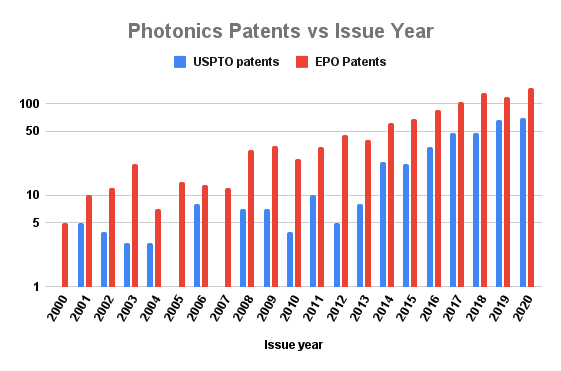For engineers and decision-makers working in the photonics industry, it is important to learn how to properly use patents in photonics.
There is a lot of prestige associated with research papers, most researchers and engineers are very proud when they can publish in famous journals.
Consequently, engineers are naturally drawn to research papers and articles when performing exploratory literature research.
It is not difficult to understand why this is the case. Papers are easier to read and have typically gone through rigorous peer review.
On the other hand, intellectual property and patents are indispensable for materializing the commercial potential of photonics know-how. The success of every photonics company (and any other tech company for that matter) depends on its ability to transform technical know-how into useful products.
In today’s knowledge ecosystem, this transformation necessarily passes through the development and protection of intellectual property.
What is a patent?
A patent is a legal document that grants its author a monopoly over the use and commercialization of the processes or devices it describes. This monopoly is usually granted for a period of 20 years.
A patent needs to be novel, non-obvious, and include an inventive step. It is typically related to a practical industrial application. It is typically not possible to patent an idea.
Patent vs research paper
On the other hand, a research paper is a report of the findings uncovered by a scientific process. These findings may be experimental or purely theoretical.
For research papers, it is not necessarily imperative to demonstrate a working prototype. It is often possible to publish a research paper about an idea.
Focusing on producing research papers makes sense if research, knowledge sharing, and career advancement are the only considerations.
However, patents are very relevant if industrial applications and commercialization are envisaged. Obtaining a patent is not as straightforward as a journal publication.
The requirements for obtaining a patent are more stringent. The patent application process can be very lengthy – sometimes lasting years.
Why is patent search important for photonics R&D?
As a photonics researcher/engineer active in product development, it is important to check out previous patents to make sure you are not infringing on someone else’s patent.
If you are instead planning to file a patent yourself, then it also makes sense to check prior patents in order to figure out if it is worthwhile to proceed with your project.
You will then adapt your approach accordingly to maximize the commercial potential of your photonics know-how. Usually, you will be assisted in this by people around you.
In a university or research institute setting, this will be the technology transfer office. In a company/industry environment, this would be the intellectual property (IP) department.
Whatever the case, it still makes sense for you to have a rudimentary idea of how patents work. This should help you become more effective in your role as an R&D engineer.
How to perform a photonics patent search
To perform a patent search you need to access a patent database and filter out patent documents that are most relevant to your work.
You can either use paid patent search tools offered by IP service providers or go with free tools. The US patent office (USPTO) and the European patent office (EPO) both have fantastic public databases.
You can search these databases on your own (free of charge) to find results relevant to your work.
It is also possible to find patent information from national patent offices as well as the World Intellectual Property Organisation (WIPO).
Performing a proper patent search entails following strict rules related to the patent data stored in a given database.
These rules are typically provided on the same web page which contains the front end of the patent database.
For example, using the patent databases of the USPTO and EPO, you can search for the number of photonics patents issued each year (for the years 2000 through 2020).
You can identify patents addressing only photonics inventions by selecting those which include the word photonics in their abstracts.

As the figure above shows, this rather crude search already yields some valuable information. You will immediately notice the number of patents in photonics has increased steadily over the past 20 years.
Over this 20-year period, the search reveals there have been 1026 (EPO’s Espacenet database) and 378 (USPTO database) patents respectively.
Also, note that Espacenet’s database contains information from the USPTO database (at least in part).
How to file a photonics patent
After completing the patent search, you can now proceed to file your own patent.
This is typically the phase where you get involved with the tech transfer office, IP department, or a specialized IP firm.
The procedures vary depending on how your organization is structured. I also found an interesting IP law firm that can assist independent inventors with their US patent applications (even if you live outside the US).
You can file your patent yourself (how cool is that). You can find more information about them here.
In case you plan to commercialize your know-how, it is imperative to file a patent. This is especially true for a field like photonics which is very research intensive.
Photonics finds applications in a wide range of industries by virtue of its status as an enabling technology. You can find more about this in our feature article on photonics technology.
A patent is a tangible asset for companies active in photonics. The protections and restrictions offered by patents provide reliable future revenue streams in the form of income through an acquisition or a licensing deal.
Patents enhance the commercialization of photonics research and development
As a photonics engineer, it is important to use patents correctly. They are not just strange documents with obscure language.
Properly searching patent databases is an invaluable tool for finding out what the other competitors in the photonics industry are doing.
You can determine (at least on an ad-hoc basis) areas that are already covered by competing claims. This ensures you avoid the costly mistake of re-inventing existing technology.
Finding out that a competitor has already patented some piece of technology you are still working on (or planning to work on) is not always a bad thing. It doesn’t matter if you are a solo inventor or working for a company.
It can be a chance for you to learn about recent developments in photonics technology with strong commercial potential.
This then allows you to focus and direct your efforts towards areas not covered by current patent claims. In this way, you can maximize the commercial output of your R&D efforts.
A thorough patent search can also be invaluable in identifying licensable photonics technologies.
This is especially interesting for companies developing products that utilize photonics technology. Such a company can develop its products in-house with specialist R&D teams.
However, this is often costly and time-consuming. These costs and timing issues can be optimized by integrating licensed photonics technology into their products.
This offers maximal flexibility in product planning ensuring the company reaches the market with its offerings at the appropriate time.
